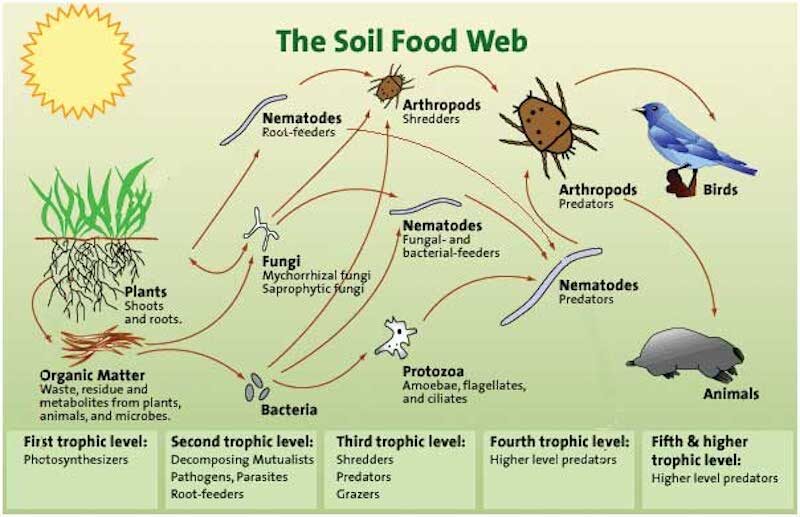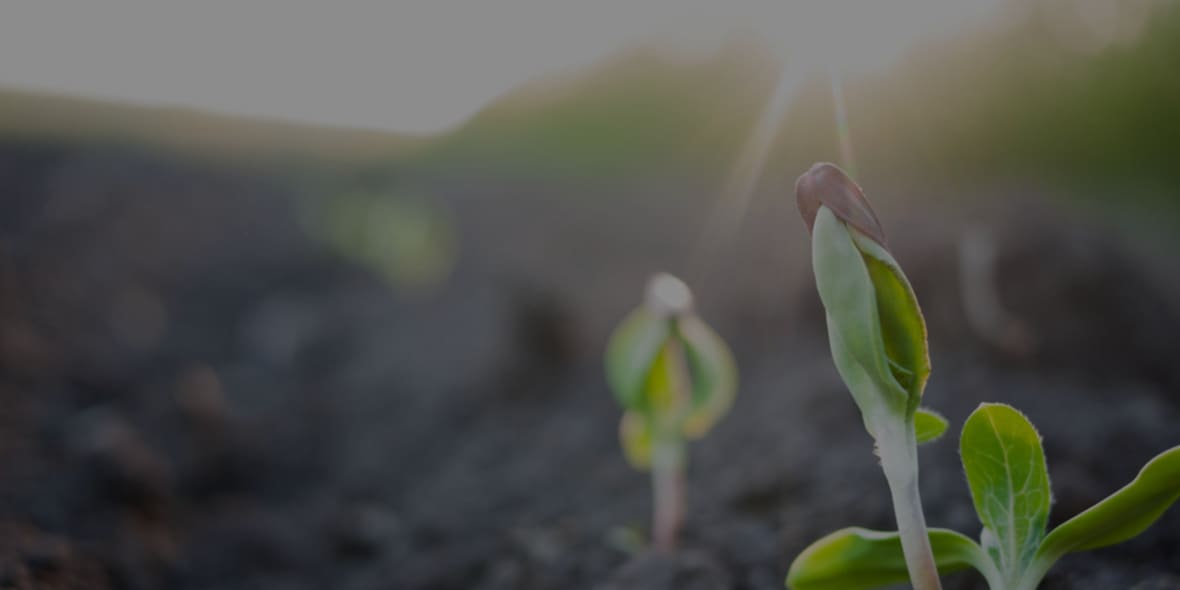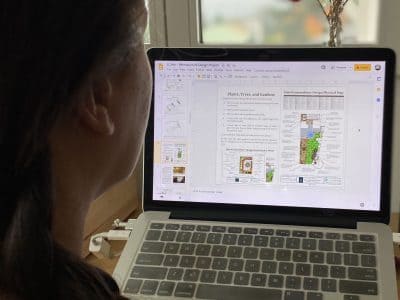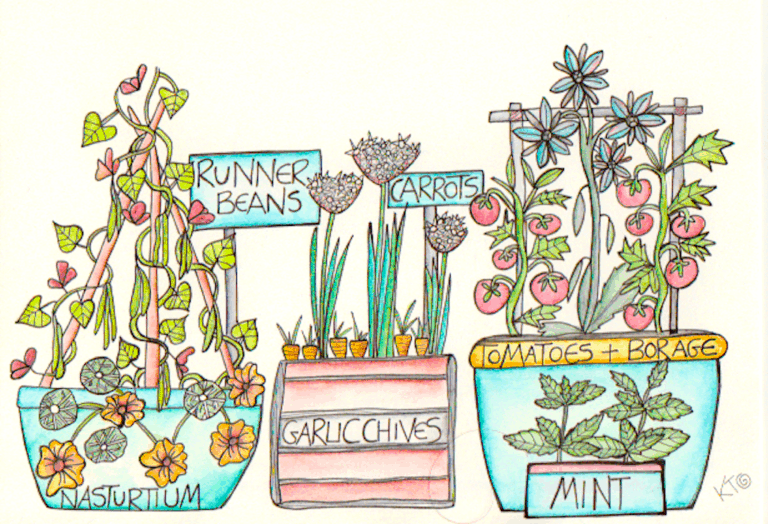
The more life you have in your soil, the more fertile it is
Once you’ve designed the water system, the next step is to build a closed-loop soil fertility system, using compost, cover crops, and a variety of homespun concoctions to improve structure, feed microorganisms, and promote a thriving, evolving soil food web.
Whether you find yourself on a site where the soil is damaged and depleted, or you’ve got amazing soil that you want to keep fertile, learning how to create and maintain healthy soil is a crucial part of the permaculture process.
There is a whole world in the dirt that we can’t see with the naked eye, upon which all life on Earth depends in so many ways.
Healthy soil, much like a healthy human body, contains a whole ecosystem of flora and fauna. This video, a classic film from Japan, shows us the many layers of life that exist in healthy soil, and demonstrates the lack of life in soil that has been mistreated with chemicals and monocropping.
Use compost to build a healthy soil food web
This section is by Lichen June
Plants are active participants in the vibrant and diverse community of soil food web. There are more than 50 million genera of bacteria in the soil, and more than 50 million genera of fungi.
Humans haven’t named more than a small percentage, and we know very little about those which we have named. Thus, the vast majority of life in the soil, along with their relationships and functions, are unnamed and unknown.
By some accounts, humans have destroyed 50-80% of earth’s topsoil. I find this so troubling, I almost don’t know what to write next. However, this is a very clear case of “the problem is the solution.” There is so much land devoid of life, so many layers and niches just waiting to be filled with diversity, life cycles, and carbon.
Soil is an incredible and established reservoir that is ready to hold carbon, if only we nurture it back to life.
One method for improving the health of your soil is adding compost. Your food is only as healthy as the soil that it was grown in, so you’ll want to give your soil biota something good to eat.
Soil Food Web: How to make your own compost
This recipe is a variation of the 18-day Berkley method, and can teach you the basics. As you gain more experience, you can change the recipe. The greater variety of matter you put into your compost, the richer your soil food web becomes. You’ll need 25-30 parts carbon to 1 part nitrogen.
Some examples:
- Sawdust is 500 parts carbon to 1 part nitrogen.
- Fish is 7 to 1.
- Urine 1 to 1.
- Chicken manure 12 to 1.
- Rabbit manure 8 to 1.
- Horse manure 20 to 1.
- Green weeds 25 to 1.
If you can increase surface area by chopping or shredding, it will speed up decomposition. You will need a lot of materials. Don’t go over 4 feet high, or it will squeeze the air out. You can use a gravity fall pile, or a piece of wire fence. You’ll need a long handled pitchfork with 3-5 prongs, a rake, and a cover to maintain moisture.
You need 1/3 of your materials to be manure, 1/3 high carbon material, or browns, and 1/3 fresh greens. Pitch them all together and mix them up. Then water the hill until it starts to leak water. If you have food scraps, those can be incorporated into the layers and covered.
Avoid materials that have come into contact with pesticides, herbicides, fungicides, antibiotic medications, and anything that will take your pH to one extreme or another.
Once you’re more familiar with this recipe, you can put an activator in the middle when you start the pile. These could include dead animals, fish, chopped comfrey, yarrow, nettle, or old compost. You have to be certain that you know your recipe, so your pile will cook and not go putrid.
Some people urinate on their compost piles to increase the nitrogen. Some add menstrual blood as an activator.
Other common activators, by % of Nitrogen:
- Alfalfa meal 2.4%.
- Blood meal 15%.
- Bone meal 4%.
- Chicken manure (dry) 8%.
- Coffee grounds 2.1%.
- Rabbit manure (fresh) 2.4%.
- Rabbit manure (dry) 12%.
Once you have built your pile, you will want to cover it if you are expecting rain. Place branches on top of the pile to hold the cover off the surface, allowing air to pass through. You can also build the pile inside to heat a greenhouse. If conditions are very hot, place your pile in the shade.
If you want to look at your compost activity under a microscope, put a handful of compost in a jar with water and shake for 10 minutes. Then get a pipette and drop one drop on a slide, under a cover sheet, to view under the microscope. Take five minutes to look at this, and you will see thousands of organisms every second.
Carbon is more of a fungal food. Nitrogen is more of a bacterial food. Non-woody plants and pasture prefer bacteria rich soil. Trees prefer fungal/carbon rich soil. Flour, paper, cardboard are all fungal food. If you want more fungi in your compost, you can add something like oat flour on every turn.
You can test the temperature of your pile with a good quality compost thermometer. If the pile is hotter on the inside than the outside, then your pile is too dry. If your pile is hotter on the outside than the inside, then your pile is too wet. Compost kept between 131 – 140 degrees for 15 days will kill pathogens, parasites and weed seeds.
If you want to speed up the compost turning process, you can turn your pile every day for 10 to 12 days and get it done faster, but it will be more work. Make sure you put the outer layer in the center when turning your pile, and the inner layer on the surface.
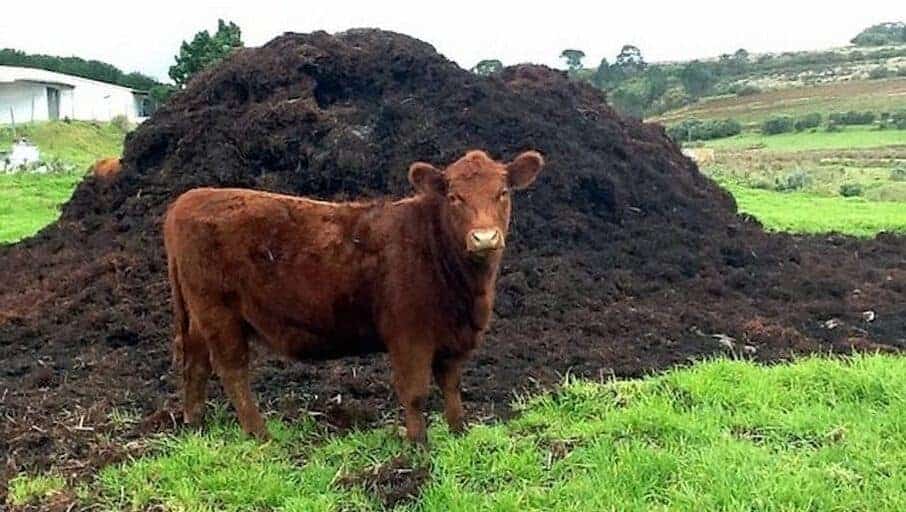
A step-by-step guide to fast composting
Day one: Create the pile.
Day four: turn it over, ideally putting the outer layers in the middle and the center on the surface, as you move and rebuild the pile. Replace branches and cover.
Day six: turn.
Day eight: Turn every two days.
How do you know if the moisture in your pile is adequate? Squeeze a handful of the matter from the compost pile. If one drop falls, it is perfect. More water than that, and the pile is too wet. No drops, and it is too dry.
The pile should also be very warm. If you put a glove on and push your arm into the pile up to your elbow, it shouldn’t be so hot that you say “Ow.”
Turn the pile on day ten, day twelve, day fourteen, day sixteen and by day eighteen it should be done. When it is just warm, dark brown, fine with only a few chunks, and an earthy smell, not putrid, then it is done.
How do you fix problems with your compost recipe? If you get to day 6 or 8 and your compost is not hot enough, ask yourself:
- Is the pile high enough?
- Is the pile wet enough?
- Is the pile too wet?
- Have you shredded the carbon small enough?
If it is high enough and wet enough, then you don’t have enough nitrogen. Get some convenient nitrogen and spread it into the pile on each turn, such as blood and bone meal, rich manure, or molasses.
You have probably lost 4-6 days, or rather, you will have to turn the pile for 4-6 extra days. If the pile is too wet, you’ve got to put a hole in the center with your pitchfork handle and place a chimney in the middle to let it steam off. If it is too dry, just water it.
If you have too much nitrogen, it will lose volume fast and smell very bad. Carbon is your sponge and carbon will slow it down. If your compost goes a little anaerobic in places for lack of air, it will present a white, moldy looking powder. That is the first indicator that you’ve gone over the line in temperature or moisture and need to make an adjustment.
You want 10 compost heaps to an acre if you want to kick off an organic crop garden system. Your soil will hold more water at the end of this process. When you get skilled at turning your pile, you can do it in 20 minutes. That’s 3 hours of work total for this 18 day recipe.
One compost heap this size, spread around a garden, will grow vegetables for one year, for one person.
How to create slow compost
Turning a pile every two days is not for everyone. If you are too busy, you can turn your pile once every 7-10 days. At that rate your compost will be finished in 1-3 months.
If you need to go more slowly, that’s okay. You can always assess what your compost needs are when you turn it, and add accordingly.
Alternately, you can make an add as you go pile. This requires even less effort, as there is no need to separate your kitchen waste, yard debris, and clippings. Unfortunately, it decomposes at a slower rate of 3-8 months.
It is prone to odor problems because the lack of turning allows it to go anaerobic. It doesn’t heat up well, which means it does not kill weed seeds and pathogens. It will be less nutrient dense. It might attract pests if uncovered.
If you mix your sieved compost with sharp river sand from the inside bends of creeks or rivers, you can make your own potting mix. The smaller the seed the more sand you want in the mix, for example, carrot seeds, etc. With large seeds you can use 50/50 compost and sand.
You can also extend your compost by making compost tea.
More ways to build and maintain a fertile soil food web
Mulch
This article discusses how and why to mulch often and well.
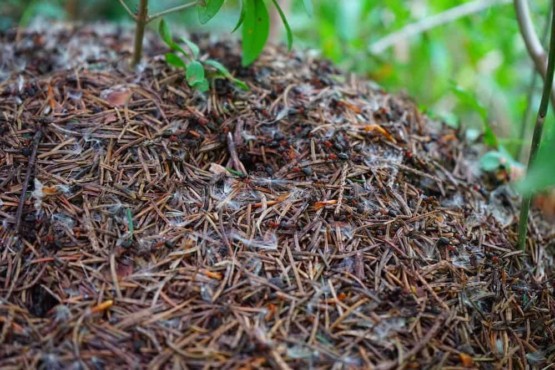
Vermiculture
Becky Ellis brings a beginner’s guide to worm composting.
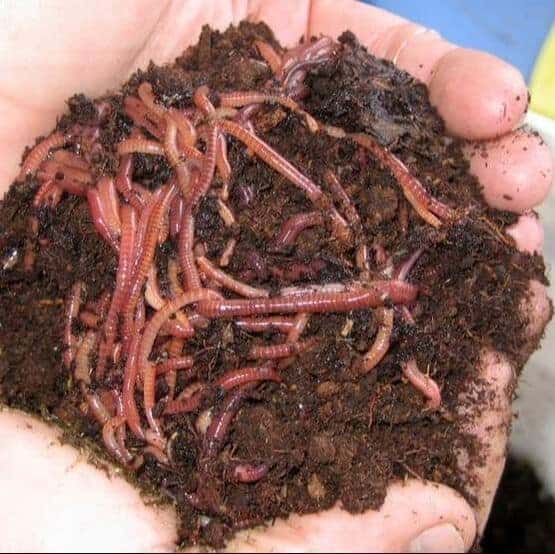
Cover Crops
Here’s Toby Hemenway, author of Gaia’s Garden, with a permaculture guide to choosing cover crops.

Carbon Farming
Check out this whole-systems approach to regenerative agriculture.
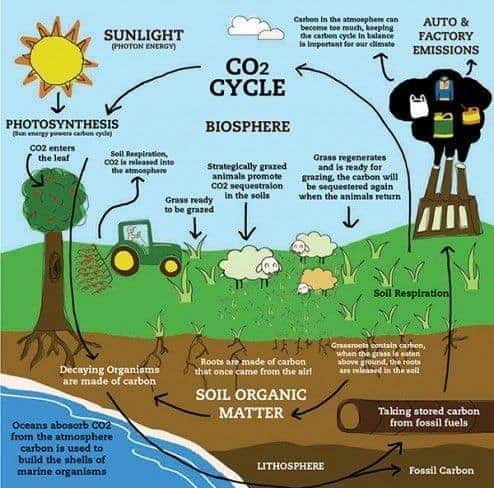
Natural Farming
A radical approach to agriculture developed by Japanese rice farmer Masanobu Fukuoka. His methods inspire, and his writing is brilliant and hilarious.
Here are his books, free PDF downloads:
Want to learn more about this and other topics related to permaculture, sustainability, and whole-systems design? We offer a range of FREE (donations optional) online courses!
Relevant Links and Resources about Soil Food Web
For a much-expanded overview of how to build healthy soil ecosystems, read the soils chapter of Food Not Lawns.

Here’s an introduction to the “no-dig” methods of Ruth Stout, the Queen of Mulch, and below you’ll find the first in a fun series of videos about using her technique to grow potatoes in the U.K.
The Permaculture Podcast, hosted by Scott Mann, is an amazing resource for hands-on permaculture knowledge from around the world. Here are two interviews focused soil food web:
Drawing Down Carbon: Eric Toensmeier on Agroforestry and Climate Change
The Soil Food Web with Jeff Lowenfels
